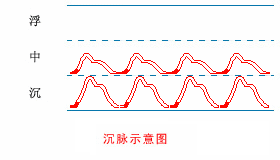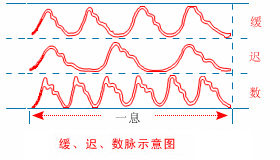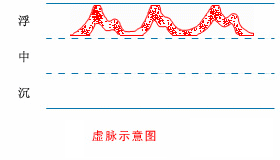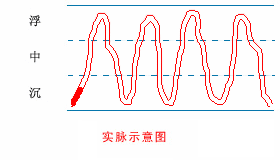▲ Click on “Little Island Prescription” above to follow health and wellness

Editor’s Note on Pulse Types
|
Ancient Chinese scholars discovered the principles of blood circulation early on and found that pulse diagnosis could reveal changes in internal organs. Pulse diagnosis involves palpating the pulse at various locations on the body to observe changes in pulse characteristics and understand the patient’s condition, making it a unique method in TCM diagnostics.
The formation of pulse types is closely related to the qi and blood of the organs. If the qi and blood of the organs undergo pathological changes, the circulation of blood vessels will be affected, leading to changes in pulse characteristics. The changes in pulse are related to the location, nature of the disease, and the balance of pathogenic and healthy qi. Today, we will explore the characteristics of the six basic pulse types: floating, sinking, slow, rapid, weak, and strong. |
Floating Pulse (Fu Mai)
The floating pulse is a single-factor pulse type with independent significance. It is characterized by a superficial pulse position, easily felt with light pressure, while medium or deep pressure yields less pronounced results or no pulse sensation at all.
The floating pulse is defined by its superficial location, situated “above the flesh,” without other influencing factors, contrasting with medium and sinking pulses that have different depths. The sensation of the floating pulse is light and easily felt; it is prominent with light pressure but diminishes with heavier pressure. When lightly pressed, the shape of the pulse vessel is clear, and the pulsation is distinct; when pressed harder, the pulse vessel is compressed, and the pulsation weakens. Metaphors for the floating pulse include “like wood floating on water,” “like objects floating on water,” and “like a feather blown by the wind.”
The floating pulse is one of the primary pulse types. Based on the floating pulse, various derived pulse types can be formed by adding related factors. There are many variations of the floating pulse, including floating rapid, floating slow, floating tight, floating thin, floating surging, floating moving, floating short, floating slippery, floating rough, floating tight, floating string-like, floating scattered, floating lactating, floating moist, floating weak, floating empty, floating strong, floating weak, floating surging large, floating weak rough, floating thin slippery, floating tight slippery, floating slippery rapid tight, floating slippery rapid, floating surging large long, floating large string hard, etc.
The floating pulse appears in a normal pulse (thin individuals, autumn, lung pulse), indicating a disease on the surface, with pathogenic factors in the yang aspect, primarily associated with wind pathogens, or indicating a deficiency syndrome in internal conditions, such as during childbirth in women. In summary, the floating pulse can result from superficial blood vessels, seasonal factors, invasion of external pathogens, internal deficiency leading to blood loss, or yang qi floating away.
Sinking Pulse (Chen Mai)
The sinking pulse is a single-factor pulse type with independent significance, not influenced by other factors. It is characterized by a deeper pulse position, where the pulsation is more pronounced with deep pressure compared to medium or light pressure. The sinking pulse is defined by its deep location, situated “beneath the muscles,” with a tendency to sink deeply, contrasting with floating and medium pulses.

The sensation of the sinking pulse is felt strongly with heavy pressure but is less pronounced with lighter pressure. When pressed heavily, the shape of the pulse vessel is clear, and the pulsation is distinct; with light pressure, the pulsation weakens. Metaphors for the sinking pulse include “like a stone sinking in water,” “like a stone falling to the bottom,” and “like sand wrapped in cotton.”
The sinking pulse is one of the primary pulse types. Based on the sinking pulse, various derived pulse types can be formed by adding related factors, and it can also combine with other pulse types. Common variations of the sinking pulse include sinking hidden, sinking rapid, sinking slow, sinking tight, sinking slow, sinking small, slippery, sinking rough, sinking lactating, sinking solid, sinking weak, sinking string-like, sinking tight, sinking firm, sinking strong, sinking weak, sinking string tight, sinking tight rapid, sinking small slow, sinking thin rapid scattered, etc.
The sinking pulse can appear in a normal pulse, indicating a disease on the surface, with a nature of yin, located internally, indicating cold, phlegm, water retention, food stagnation, qi disorders, emotional disturbances, or pain. In summary, the sinking pulse can result from hidden qi and blood, seasonal factors, excess qi, food, phlegm, and other conditions, as well as from organ deficiency leading to insufficient righteous qi, or from yin excess and yang deficiency leading to cold symptoms.
Slow Pulse (Chi Mai)
The slow pulse is a single-factor pulse type with independent significance. It does not include any other elements beyond frequency changes. The slow pulse is defined by its rate, with fewer than four beats per breath, typically three beats, and can be as low as one breath with three beats.(Editor’s Note: The “Suwen” (Plain Questions) states: “When a person exhales, the pulse moves once; when inhaling, the pulse moves again. When breathing is steady, the pulse moves five times, and the normal pulse rate should be around five beats for each breath.”)
The slow pulse, along with the slow and rapid pulses, forms a series of variations in pulse frequency.
The slow pulse is one of the primary pulse types. Based on the slow pulse, various derived pulse types can be formed by adding related factors, and it can also combine with other pulse types. Common variations of the slow pulse include slow floating, slow sinking, slow slow, slow tight, slow thin, slow rough, slow slippery, slow string-like, slow tight, slow weak, slow strong, slow sinking thin rapid, etc.
The slow pulse can appear in a normal pulse, indicating a nature of yin or cold, primarily associated with deficiency syndromes, internal conditions, organ diseases, or can indicate heat syndromes, excess conditions, or during pregnancy. In summary, the slow pulse can result from a broad and gentle nature, seasonal factors, or conditions where the nature is yin, qi and blood are stagnant, or where the nature is yang, leading to pulse stagnation, as well as during the first three months of pregnancy or due to blood deficiency and heat accumulation.

Rapid Pulse (Shu Mai)
The rapid pulse is a single-factor pulse type with independent significance. It does not include any other elements beyond frequency changes. The rapid pulse is defined by its rate, with more than five beats per breath, typically six beats, and can be as high as six or more beats.
The rapid pulse is one of the primary pulse types. Based on the rapid pulse, various derived pulse types can be formed by adding related factors, and it can also combine with other pulse types. Common variations of the rapid pulse include floating rapid, sinking rapid, surging rapid, thin rapid, string rapid, slippery rapid, weak rapid, rapid strong, rapid surging slippery, sinking thin rapid, slippery solid rapid, thin small string rapid, etc.
The rapid pulse can be seen in a normal pulse, indicating heat, yang, or deficiency, with the disease located in the bowels, indicating excess pathogenic factors, vomiting, mania, qi counterflow, pain from sores, rashes, tumors, pregnancy, or dysentery. In summary, the rapid pulse can result from accelerated qi and blood circulation, excess heat in the blood, or floating yang qi.
Weak Pulse (Xu Mai)
The broad definition of the weak pulse refers to a general term for weak pulses, indicating weak pulse strength, and is a single-factor pulse type.

The narrow definition of the weak pulse is a composite pulse type with several factors, not a single-factor pulse type; the weak pulse has the combined conditions of being slow, large, soft, and weak.
The narrow definition of the weak pulse differs from a simple weak pulse and can coexist with other pulse types without contradiction. The broad definition of the weak pulse includes variations such as floating weak, sinking weak, weak slow, weak slow, weak rapid, weak slippery, weak rough, weak string-like, weak micro-thin, weak floating large rapid, weak weak thin rapid, etc.
The weak pulse can appear in conditions of deficient righteous qi, blood deficiency, qi and blood deficiency, fatigue, or heat injury. In summary, yang deficiency, qi deficiency, blood deficiency, and heat injury can all lead to a weak pulse.
Strong Pulse (Shi Mai)
The broad definition of the strong pulse refers to a pulse that is strong under both light and heavy pressure.

The narrow definition of the strong pulse is a composite pulse type with several factors, not a single-factor pulse type; the strong pulse has the combined conditions of being large, long, string-like, and strong, present in floating, medium, and sinking pulses.
The narrow definition of the strong pulse differs from a simple strong pulse and can coexist with other pulse types without contradiction. The broad definition of the strong pulse includes variations such as floating strong, strong slow, strong large, strong tight, strong slippery, strong surging slippery, strong rapid large, sinking strong, etc.
The strong pulse can appear in conditions of excess qi, solid blood, yang stagnation, excess fire, or excess pathogenic factors. In summary, excess pathogenic factors filling the pulse pathways and excessive yang qi floating away can lead to a strong pulse.
| Author Introduction |
Yang Jie, female, Chief Physician at the China Academy of Chinese Medical Sciences, Doctor of Medicine, Postdoctoral Fellow. She has published over ten academic papers and authored a series of books including “Secret Recipes for Cancer Treatment,” “Dietary Therapy for Cancer,” and “Chinese Herbal Medicine for Cancer.”
Source: Excerpted from “Chinese Pulse Diagnosis” edited by Yang Jie, published by Beijing Science and Technology Press. Images sourced from the internet.
If you like this article, remember to click the “Read” button at the bottom right of the article or share it with your friends!If you have any questions, feel free to leave a comment below~
— END —
★The above content is for reference only; please consult a qualified hospital if you have any health concerns.★
Copyright Statement: This content and images are compiled from the internet, and this platform focuses on sharing and communication, not for commercial use. If there is any infringement, please contact the editor for deletion. Please indicate the source when reproducing this content.
Reminder: The adjustment methods shared on this platform are for reference only and may not be suitable for everyone. It is recommended to adjust under the guidance of a physician.
| Click Keywords for Quick Search | |||
| Check Meridians | Fruit Dietary Therapy | Health Check Report | Comprehensive Dietary Therapy |
| Check Acupoints | First Aid Manual | Huangdi Neijing | Chinese Medicine Query |
| Shanghan Lun | Home Remedies | Acupuncture Point Matching | Anti-Epidemic Soup |
| Chinese Medicine | Foundations of TCM | Acupuncture | Common Knowledge of Moxibustion |
| Warm Disease Studies | Seasonal Queries | Acupoint Massage | Stomach Disease Adjustment |
| Formulary Studies | TCM Diagnosis | Shennong Bencao | Tongue Diagnosis Atlas |
| Pediatrics | TCM Surgery | TCM Gynecology | Jin Kui Yao Lue |
| Internal Medicine | Yijing Mysteries | Meridian Points | From Head to Toe |
| Facial Diagnosis | Gua Sha Therapy | Foot Bath Health | TCM Tongue Diagnosis |
| Hand Diagnosis | Yijing Wisdom | Moxibustion Care | Hand Health Knowledge |

